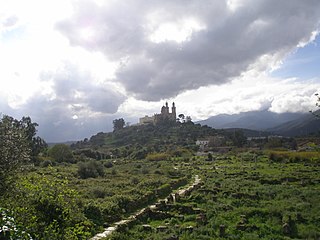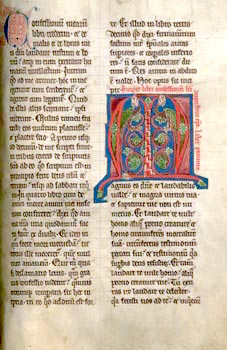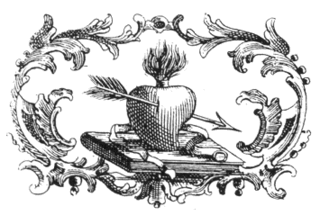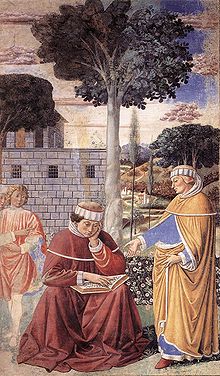
Augustine of Hippo, also known as Saint Augustine, was a theologian and philosopher of Berber origin and the bishop of Hippo Regius in Numidia, Roman North Africa. His writings influenced the development of Western philosophy and Western Christianity, and he is viewed as one of the most important Church Fathers of the Latin Church in the Patristic Period. His many important works include The City of God, On Christian Doctrine, and Confessions.

Paulinus of Nola born Pontius Meropius Anicius Paulinus, was a Roman poet, writer, and senator who attained the ranks of suffect consul and governor of Campania but – following the assassination of the emperor Gratian and under the influence of his Hispanic wife Therasia of Nola — abandoned his career, was baptized as a Christian, and probably after Therasia's death became bishop of Nola in Campania. While there, he wrote poems in honor of his predecessor Saint Felix and corresponded with other Christian leaders throughout the empire. He is credited with the introduction of bells to Christian worship and helped resolve the disputed election of Pope Boniface I.

Hippo Regius is the ancient name of the modern city of Annaba, Algeria. It historically served as an important city for the Phoenicians, Berbers, Romans, and Vandals. Hippo was the capital city of the Vandal Kingdom from 435 to 439 AD. until it was shifted to Carthage following the Vandal capture of Carthage (439).

Augustinians are members of several religious orders that follow the Rule of Saint Augustine, written in about 400 AD by Augustine of Hippo. There are two distinct types of Augustinians in Catholic religious orders dating back to the 12th–13th centuries:

Confessions is an autobiographical work by Augustine of Hippo, consisting of 13 books written in Latin between AD 397 and 400. The work outlines Augustine's sinful youth and his conversion to Christianity. Modern English translations of it are sometimes published under the title The Confessions of Saint Augustine in order to distinguish the book from other books with similar titles. Its original title was Confessions in Thirteen Books, and it was composed to be read out loud with each book being a complete unit.

Monica was an early North African Christian saint and the mother of Augustine of Hippo. She is remembered and honored in the Catholic and Orthodox Churches, albeit on different feast days, for her outstanding Christian virtues, particularly the suffering caused by her husband's adultery, and her prayerful life dedicated to the reformation of her son, who wrote extensively of her pious acts and life with her in his Confessions. Popular Christian legends recall Monica weeping every night for her son Augustine.

The Rule of Saint Augustine, written in about the year 400, is a brief document divided into eight chapters and serves as an outline for religious life lived in community. It is the oldest monastic rule in the Western Church.

Marcellina was born in Trier, Gaul the daughter of the Praetorian prefect of Gaul, and was the elder sister of Ambrose of Milan and Satyrus of Milan. Marcellina devoted her life as a consecrated virgin to the practice of prayer and asceticism. Her feast is on 17 July.

Thagaste was a Roman-Berber city in present-day Algeria, now called Souk Ahras. The town was the birthplace of Saint Augustine.
Possidius was a friend of Augustine of Hippo who wrote a reliable biography and an indiculus or list of his works. He was bishop of Calama in the Roman province of Numidia.

The Order of Saint Augustine, abbreviated OSA, is a religious mendicant order of the Catholic Church. It was founded in 1244 by bringing together several eremitical groups in the Tuscany region who were following the Rule of Saint Augustine, written by Saint Augustine of Hippo in the fifth century.

Simplician was Bishop of Milan from 397 to 400 or 401 AD. He is honoured as a Saint in the Roman Catholic and Eastern Orthodox Churches and his feast day is August 14.

Souk Ahras is a municipality in Algeria. It is the capital of Souk Ahras Province. The Numidian city of Thagaste, on whose ruins Souk Ahras was built, was the birthplace of Augustine of Hippo and a center of Berber culture.
Restless Heart: The Confessions of Saint Augustine is a 2010 two-part television miniseries chronicling the life of St. Augustine, the early Christian theologian, writer and Bishop of Hippo Regius at the time of the Vandal invasion.

Calama was a colonia in the Roman province of Numidia situated where Guelma in Algeria now stands.

Thiava was an ancient Roman-Berber civitas in Numidia, Africa Proconsulare and in the Vandal Kingdom. It was a Latin Catholic diocese.

The Diocese of Thagaste is an ancient and famous Titular See of the Roman Catholic Church.

Michael Hurley was an American Catholic priest and an Augustinian friar. He served as pastor of St. Augustine Church in Philadelphia for seventeen years, as vicar general of the American province of the Order of Saint Augustine, and as vicar general of the Diocese of Philadelphia.
Albina was a late Roman religious patron, correspondent of St Augustine and was the mother of Melania the Younger.















